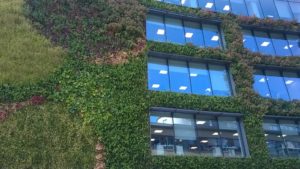In our recent workshop, friends of nature and buildings came together to discuss natural capital in the built environment. We discussed drivers, barriers and solutions to implementing the natural capital approach as well as initiatives to embed the natural capital approach in the built environment sector.
Download our report from the workshop

Photo courtesy of Arcadis UK
It makes sense
There is a genuine interest in increasing natural solutions in the built environment. It makes political, financial and environmental sense. The UK is committed to national and international biodiversity, water and air quality targets, and the built environment sector plays an important part in improving urban environments for nature and people. By creating high quality places, developers and local authorities can contribute to the sustainability and climate resilience of urban environments as well as the health and wellbeing of urban people.
Talking the talk…
However, the message of natural capital is not always clear. We need to communicate natural capital benefits better by using clearer language and more engaging messages. In our workshop, we heard some such examples from advocates of the natural capital approach in the built environment sector.
In her presentations, Martina Girvan from Arcadis stressed the importance of natural capital in sustainable urban developments. Her colleague Renuka Gunasekara discussed the financial benefits of Sustainable Drainage Systems. We also heard from Alexandra Collins from Imperial College about Defra’s Local Action Project, which offers local communities tools to enhance natural capital in urban environments. Laura Boccadamo talked about The Berkeley Group’s commitment to net biodiversity gain. In conclusion, Lizzie Rendell from Skanska encouraged us to participate in developing the built environment sector guide for the Natural Capital Protocol.
… and walking the walk
In our discussions, participants stressed the importance of partnerships, and sharing knowledge from good case studies. Developers and local authorities want more information about the costs and benefits of natural capital investments. We also need political leadership and industry advocates to develop a sustainable planning framework linked to the Government’s health and environment goals. Future planning policies need to account for natural capital throughout the project cycle and beyond. Eventually, natural capital needs to be accounted for in the markets too.
Please share your thoughts on natural capital in the built environment by email (secretariat@naturalcapital.org.uk) or on Twitter @NCI_NatCap #NatCapBuilt.
